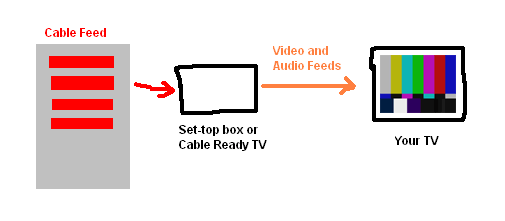At the office I sometimes have to explain things to people about the way that television works. I'm a television engineer, so it all makes sense to me, but to many it's a mystery. So today I present:
How TV gets to your house

First, you have to make the leap of faith that television networks make a channel in some way and add in all the programs, promos, and commericals that you love. The signal is feed to a large (usually 30 feel in diameter) dish that shoots the signal up into space. The dish and equipment that shoots the signal into space is called a Earth Station.
Up in outer space is a special communications satellite that orbits 22,300 miles up. To compare, the Shuttle visits the Space Station at about 250 miles. This orbit is called a geosynchronous orbit and is about a tenth of the way to Moon. It's way the hell out there.
The satellite listens to the Earth Station and immediately rebroadcasts the signal back down toward Earth. This allows many places to all see the same signal.
The local cable company has a smaller receive antenna (usually from 10-20 feet in diameter) that is pointed at the satellite and listens for the TV signal.

The receive antenna pulls down the signal and feeds it into a special receiver called an IRD (Integrated Receiver/Decoder). The IRD is very much like a radio that converts wireless signals into something you can see and hear. The IRD sends the channel to a set of modulators that combines all the other channels that the cable company assembles into a single cable feed.
Television networks all over the country bouncing signals up into space and down to cable companies, allowing them to put the various channels all together in their line up. They take ESPN from Connecticut, and HBO & MTV from New York, and Disney Channel from California and a hundred other channels and modulate them all together into a single feed.

Once the cable company has combined all the channels, they send it down the wires that they hung from telephone poles or put underground in your street.
The cable signal gets split over and over as it branches into various neighborhoods and then into specific houses. Even at your house, the signal is split again to the various rooms you want cable. Each time you split the cable signal you cut the power level down significantly. Many people have crappy pictures from cable TV and it's often due to low cable signal strength.

To understand what happens in your house, you need to learn a little physics. When you tune an FM radio, you are changing the frequency you are tuning to to change stations. It seems clear that when you go from 93.1 MHz to 103.1 MHz, you are changing stations.
Television works in a similar way. To change stations, you are changing the frequency you are tuning in. A long time ago, the television engineers thought that it might be simpler to give channels numbers instead of frequencies to refer to when tuning. At the time, they only imagined that there might be a dozen or so channels. Channel 1 was reserved for testing and so the first real channel was 2. That's why Channel 2 is the lowest channel most people are used to.
In cable TV, the amount of bancwidth or space to shove channels is usually between 50 MHz and 800 MHz. Yes, that means that the FM stations are right in the middle of the TV band. But radio bandwidth is so small, it doesn't take up much space.
Each TV channel takes up around 6 MHz of space, so you can place around 125 channels on a typical analog cable feed. Digital cable systems work differently and I won't go into it here.
So you can now see that when you change channels, you are actually choosing a different frequency to tune in, just like a radio dial. Old people, like me, can actually remember TVs that tuned with dial like a radio. I doubt my daughters have ever seen a TV with a dial on it.

OK, now that you understand how frequencies map into channels, you can see that a set-top box from the cable company is tuning the channels for you. A cable ready TV is a TV that can tune in the higher channels that only exist in the cable world and not in the over-the-air antenna world.
The cable set-top makes audio and video (or sometimes a Channel 3 signal) that you plug into your your television.
To explain this, I've skipped over a lot of details and didn't get into digital cable, direct to home satellite, HDTV, or many of the other modern methods of television distribution.
I can explain those things if you all are interested, but all of them are variations on the basic idea of television distibution I describe here. Ask away...
Posted by michael at August 18, 2005 10:36 PM